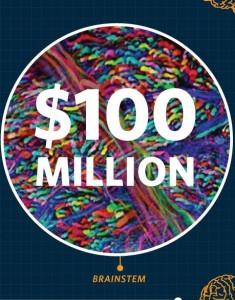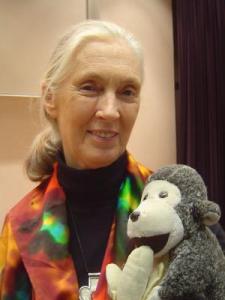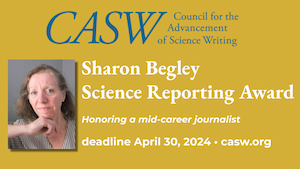WHEN IT'S BRAINS, IT POURS $$$$$. The government agency in charge of thinking up cutesy acronyms for big projects has decided that BAM won't do at all, too bellicose for PR purposes. So the Brain Activity Map, the big push for US neuroscience we talked about here a few weeks ago, will henceforth be known as BRAIN, short for Brain Research through Advancing Innovative Neurotechnologies.
I had planned to make fun of that, but on consideration have concluded that the name change is not just a grab for a classier, taxpayer-friendly label. It appears to reflect actual improvements in the plan. Partha Mitra, who maps mouse brain circuits at Cold Spring Harbor and used to be a skeptic, told Dylan Matthews at Wonkblog that the plan President Obama announced on Tuesday was "moderate" and much better.
It was really a proposal to make a proposal, Mitra said: Spend $100 million in fiscal 2014 for technology development and then think about spending even more money in subsequent years on work still to be defined. Mitra does a good job of outlining what some of that work might consist of.
For trustworthy summaries of as much detail as there is about BRAIN at the moment, see Meredith Wadman at the Nature NewsBlog with video of the proceedings and Carl Zimmer at The Loom. Get the goods also from Gary Stix at SciAm's Talking Back, from whom I "borrowed" the hed for this section. (See Jane Goodall discussion below.) Stix pretends to cynicism, but in his soul he's a BRAIN believer:
It’s one of the most clever — and most cleverly (and justifiably) hyped — ways to promote a major undertaking in basic biological research. Despite the elaborate P.R. cloak, it is probably deserving of support by scientist and non-scientist alike. “Probably” only because many of the devilish details are still to come.
Money will come mostly from the National Institutes of Health and the Defense Advanced Research Projects Agency (DARPA), with contributions from the National Science Foundation and private foundations. Heading the effort to figure out exactly what work BRAIN will be underwriting will be two top-flight neuroscientists: Cori Bargmann, who studies behavior in the worm C. elegans at The Rockefeller University and Bill Newsome, who studies monkey behavior at the Stanford School of Medicine. The first funding announcements are expected during the summer.
Wired's Greg Miller did a Q&A with one of them, Bill Newsome, who says that BRAIN won't be big and centralized and he hopes it will get new money rather than cannibalize existing funding plans.
WHERE IS BRAIN HEADED? WHO KNOWS? Talk about an open-ended undertaking. Completion of the The Human Genome Project was announced formally, with trumpets, on a number of occasions, 3 or 4 at least as I recall. But eventually it really was finished, and researchers could go to town refining and expanding the data it generated. It's hard for our cocksure selves to imagine that there can ever be an end to our fascination with the brain. We routinely claim that the H. sap version is the most complex object in the known universe.
Two points to keep in mind about the nuts and bolts of BRAIN. First, at the beginning at least, this project is largely about developing technologies for doing neuroscience. In the course of it, of course, much neuroscience will have to be done, and much will be learned about brain meat. But the point will be a sort of crash program for creating machines of one kind or another. This is just speculation, but I wonder if the White House has signed on in part to boost the still-sagging economy. Is this a stealth program to keep the U.S. at the forefront of neuroscience innovation and create jobs in the process? It couldn't hurt.
The other point to keep in mind is that this work will not be about the human brain at first, except indirectly and often only inferentially. As I pointed out last time, the work will be done largely in model animals. So it's reasonable to appoint, as co-czars of BRAIN, folks that work on C. elegans and monkeys rather than with the most complex object in the known universe.
At the Atlantic, Dana Smith implies that BRAIN is a human project, a U.S. attempt to compete with Europe's ginormous Human Brain Project, which plans to develop a computer simulation of the human brain.
Smith presents BRAIN as a connectome project without mentioning that there's already a U.S. Human Connectome Project. As Miller pointed out in another Wired post, the difference between the Connectome Project and BRAIN is that BRAIN is aimed at letting us watch neurons in action in real time, whereas the former is to be a static map. This post, BTW, also speculates on three technologies BRAIN will tackle: neuro-nanotech, optical biology, and synthetic biology sensors.
THE BRAIN IS EASY. THE MIND IS HARD. John Horgan, SciAm's chief skeptic of science, is skeptical about the European project and about BRAIN too. He compares it with the 1990s Decade of the Brain, a big push for neuroscience launched with similar high hopes and high hype that failed to live up to expectations. Horgan fears that BRAIN could damage the field's credibility.
In the Wired Q&A, Newsome seems to think that mapping the brain will give us a handle on the mind.
The great questions about how behavior and cognition emerge from the nervous system are not going to be answered at the molecular level. They’re going to be answered by looking at how systems of neurons are engaging in coordinated activity and coordinated computation. Our ultimate goal is to understand how the mental states that we experience every moment of our waking lives are related to brain states.
This is the kind of extravagant talk that people like Horgan are worried about. At 13.7, Marcelo Gleiser notes that the brain is easy, but the mind is hard.
At Mindblog, Deric Bownds says BRAIN is "completely misguided" and the idea that the project will give us a handle on the mind is "borderline delusional."
But suppose Bownds is wrong and neuroscientists were to succeed, eventually, at a complete understanding of the relationship between mental states and brain activity. Would knowing everything about how the mind works be a Good Thing? Not likely. Prevention and cure of brain disease is desirable in the abstract, but the opportunities for manipulation and mischief would be vast. So perhaps we should wish the BRAIN-y folks something less than ultimate triumph over the skeptics.
US BUDGET CUTS NEWS. The science establishment has launched a campaign to emphasize how the sequester budget cuts are hurting research. But it's not just research that's affected. The clinic — not to mention patients — feel the pain too. Wonkblog's Sarah Kliff reports that cancer centers are turning Medicare patients away on grounds that they can't afford to administer chemo.
JANE GOODALL, IT TURNS OUT, IS NOT 2013'S JONAH LEHRER. For a while there I thought the hoohah over the "borrowings" and other sins in Jane Goodall's new book would become this year's science book plagiarism scandal. But it appears that is not gonna happen.
Saint Jane has apologized, limply, for the passages lifted from other sources, some of them odd, as disclosed first by Steven Levingston in the Washington Post. She has vowed corrective action, and the book, scheduled for publication this month, has been postponed, according to Jenny Hendrix at Jacket Copy, the LA Times's book news blog.
It is perhaps relevant to point out that Goodall had a co-author on Seeds of Hope, freelance Gail Hudson. The Post dug up some bio information on Hudson, including the fact that she had been "for many years" the spirituality editor at Amazon.com. What do you suppose that means? Nothing reassuring, certainly. Hudson has written about natural health, spiritual growth, and parenting.
Goodall has said she wants to correct errors and give proper sourcing. I imagine that's true enough, but among the purloined passages identified were ones taken from tea company and astrology web sites. Is she really going to give credit for those?
Michael Moynihan, who made mincemeat out of Jonah Lehrer, nailing down his authorial transgressions chapter and verse, has performed a similar public service on Seeds of Hope at Book Beast. But more troubling than the liftings and borrowings and outright transfers from non-Goodall sources, he said, was
Goodall's embrace of dubious science on genetically modified organisms … her chapter on the subject is riddled with unsupportable claims backed by dubious studies.
At Collide-a-Scape, Keith Kloor wants to know why greens like Goodall are seduced by anti-biotech charlatans. He also observes:
… most greens and foodies not only tolerate anti-GMO craziness, they wink at it. Why is that?
I would surely like to see Kloor answer his own questions. I'll bet he has some useful speculations.
As Knight Science Journalism Tracker Faye Flam pointed out, in Dame Jane Goodall's case the media have been "deferential." I won't say that a conspiracy of silence has surrounded this not-quite-a-scandal, but there has certainly been a media consensus on low visibility and gentle descriptive terms like "borrowings" instead of "plagiarism." Compare with the hullabaloo surrounding the previous science book plagiarism scandal, that of Jonah Lehrer. I have been almost feeling sorry for Lehrer. Almost.
Flam wonders if 78-year-old Goodall's memory is failing. Maybe — although the older I get, the more I resist that sort of excuse. Mike the Mad Biologist has an alternative explanation that for me has the ring of truth. He writes:
the reason she’s getting a ‘free pass’ is because no one believes she actually wrote the damn thing, which is just as damning


.png)

